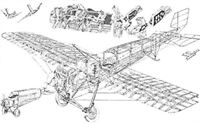R.Abate,G.Alegi,G.Apostolo Aeroplani Caproni: Gianni Caproni and His Aircraft, 1910-1983
The unsuccessful participation in the Italian Army’s 1913 competition for a military airplane, in which Caproni had entered a new monoplane design, ultimately had a positive conclusion: the aircraft rejected in Turin for reasons having little to do with its qualities was later selected specifically for the reconnaissance role by a board comprising the Army’s best pilots and engineers. Thus a small batch of Ca.18 were ordered, while some thought was given to ordering significant numbers in a program involving several other manufacturers. When this opportunity dissolved, the six Ca.18 built were assigned to an observation squadriglia serving in Piacenza with the siege artillery depot and becoming the first aircraft of indigenous design and manufacture in Italian service.
Показать полностью
J.Davilla Italian Aviation in the First World War. Vol.2: Aircraft A-H (A Centennial Perspective on Great War Airplanes 74)
Caproni Prewar Designs
Ca.17 - Similar to the preceding Ca.16 but adapted to meet all the requirements of the first military competition in Torino in 1913. There were two pilots with dual controls; the wings could be removed in five steps. The airframe was strengthened to withstand the rigors of military service.
Caproni entered both this modified design, as well as completely new design in the competition - see entry for Ca.18.
During the preliminary tests, Slavorosoff’s Caproni crashed seriously injuring the pilot and killing the passenger Francesco Gallo. The second Caproni was also involved in an accident later.
The failure forced Gianni Caproni to sell his company to the State, in effect becoming the technical director for his own company, ironically, the competition resulted in no contracts being awarded to any company, including the winner.
Ca.17 two-seat military aircraft with one 80-hp rotary engine
Wingspan 11.80 m; length 7.88 m; height 2.70 m wing area 24 sq m
Empty weight 400 kg - Payload 250 Kg.
Maximum speed 110 km/h
One built
Ca.18-19 - After the failure of the 1913 Caproni in the military competition, Gianni Caproni had no choice but to sell his company to the State, in effect becoming the technical director for his own company. While repairs became the main task of the workshop, Caproni was able to continue the design activity, still creating several prototypes. Caproni designed the Ca.18 monoplane, a two-seater for observation conceived, through the intermediate type Ca.17, around the specifications of the Aviatori Battaglia on the basis of the experience made with the Bristol (see above).
This new two-seater monoplane with 80 hp Gnome engine was built for the military competition for Italian-designed airplanes, held by the Ministry of War in Turin in 1913. The aircraft had to have removable and foldable wings to make it transportable on the road. The first model made the journey from Vizzola to Turin towed, covering 150 km.
The aircraft had a wooden fuselage with a trellis structure, steel tube tail and two metal spar wing with wooden ribs, elastic shock absorbers. The engine was an 80-hp Gnome (replaced by a Le Rhone of the same power on the Ca.19 version). There was a sheet metal firewall.The landing gear consisted of two large diameter wheels and without a central skid. The Ca.18 also featured side windows to give the pilot a better view of the ground.
In 1914 15a Squadriglia was equipped with Bleriot 11s, but in April 1915 it re-equipped with the Caproni Parasol Ca.18s and had nos. 228, 229, 230, 231, 232, 233, 234 on strength. Assigned to III Gruppo at the outbreak of the war it was based at Piacenza. On 24 June it was sent to Pordenone for the Parco d’Assedio di Artiglieria (Artillery Siege Park to transition to Caproni Parasol 100 hp Ca.24s, which were picked up at Vizzola Ticino. In May 1915 the five Ca.18s still in service were SOC.
Caproni Ca.18 two-seat army co-operation aircraft with one 80-hp Gnome engine (Ca.20 had an 80-hp Le Rhone)
Wingspan 10.93 m; length 7.60 m; height 2.93 m; wing area 21.60 sq m
Empty weight 400 kg; loaded weight 695 kg
Maximum speed 20 km/h; climb to 1,000 m in 10 min; ceiling 2,000 m
Показать полностью






